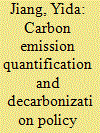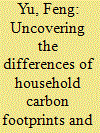|
|
|
Sort Order |
|
|
|
Items / Page
|
|
|
|
|
|
|
| Srl | Item |
| 1 |
ID:
176761


|
|
|
|
|
| Summary/Abstract |
The household sector has been identified as a major driver of the economy and an important contributor to greenhouse gas (GHG) emissions. It is also pointed out by existing studies that influential factors of household emissions range from socioeconomic to geographic aspects. Promoting efficient and feasible decarbonization actions therefore calls for the quantification of the variability in emission patterns and its relationship with contextual factors. In this study, using data on monthly household expenditures at the city level, direct and indirect carbon emissions resulting from household consumption in 51 major Japanese cities in 2011 are calculated. A regression analysis is also conducted to explore the relationship between emissions from the household sector and the socioeconomic, demographic, and climatic characteristics of Japanese cities. Our results indicate seasonality and categorical differences in residential carbon emissions for cities in Japan. We also find per capita income, urban population density, and proportion of the population over 65 years old to be the most influential variables that shape the residential emission landscape of Japanese cities. We thus suggest that seasonality, categories of consumption, and city characteristics be considered as crucial factors in policy making for emission mitigation targeting consumption behavior of urban residents.
|
|
|
|
|
|
|
|
|
|
|
|
|
|
|
|
| 2 |
ID:
191406


|
|
|
|
|
| Summary/Abstract |
The significant spike in global energy prices induced by the Russian-Ukrainian (RU) conflict is perceived as highly uncertain that may rise household living costs and adversely affect Sustainable Development Goals such as poverty elimination. However, the impacts on human wellbeing are entirely obscured by conventional economic analyses. Using the input-output price model and a human needs framework, we assess the impact of energy price shocks caused by the RU conflict on eight dimensions of human needs in 49 countries/regions. Our findings show that the non-material dimension Creation and the material dimension Protection are the most affected human needs globally, with declines of 3.7%–8.5% and 3.6%–8.4%, respectively. Households in BRICS countries are hit hardest on these human needs (2.0-2.2 times the global average) owing to higher price increases and higher energy-dependent consumption patterns. The human need satisfaction of low-income groups is not only severely affected, but also the poorer the country in which they reside, the more serious the decline of their satisfaction, while there is no such problem for higher income groups. Our findings underscore the need to consider both material and frequently overlooked non-material dimensions of wellbeing when designing targeted policies to protect the vulnerable from energy price shocks.
|
|
|
|
|
|
|
|
|
|
|
|
|
|
|
|
| 3 |
ID:
126551


|
|
|
|
|
| Publication |
2013.
|
| Summary/Abstract |
Household consumption requires energy to be used at all stages of the economic process, thereby directly and indirectly leading to environmental impacts across the entire production chain. The levels, structure and determinants of energy requirements of household consumption therefore constitute an important avenue of research. Incorporating the full upstream requirements into the analysis helps to avoid simplistic conclusions which would actually only imply shifts between consumption categories without taking the economy wide effects into account. This paper presents the investigation of the direct and indirect primary energy requirements of Australian households, contrasting urban, suburban and rural consumption patterns as well as inter- and intra-regional levels of inequality in energy requirements. Furthermore the spatial and socio-economic drivers of energy consumption for different categories of energy requirements are identified and quantified. Conclusions regarding the relationships between energy requirements, household characteristics, urban form and urbanization processes are drawn and the respective policy implications are explored.
|
|
|
|
|
|
|
|
|
|
|
|
|
|
|
|
| 4 |
ID:
188541


|
|
|
|
|
| Summary/Abstract |
Reducing inequality in energy consumption is critical for sustainable development and the achievement of climate goals. Using an environmentally extended input-output analysis, this study measured the urban household energy consumption of different income groups in China for the years 2012, 2015, and 2017. Gini coefficients were used to measure inequality within each province, while the regional environment inequality index was used to measure inequality between provinces. The energy consumption showed a decreasing trend from the eastern coast to the western interior. In contrast, the per capita energy consumption showed an increasing trend from the southeastern coast to the northwestern interior. In 2015, the high-income groups accounted for 45% of the country's total energy consumption, while the low-income groups accounted for only 4%. Between 2012 and 2017, the level of inequality in energy consumption between provinces gradually increased, while the level of inequality within provinces gradually decreased. Among the various consumption categories, the Gini coefficients for necessities were generally smaller, whereas those for services were generally larger. However, the differences between consumption categories gradually decreased.
|
|
|
|
|
|
|
|
|
|
|
|
|
|
|
|
| 5 |
ID:
136211


|
|
|
|
|
| Summary/Abstract |
We investigate the impacts that oil price shocks have on residential consumption in China. While it is well understood that oil prices affect consumption in a multitude of ways, the timing and directness of these effects on specific consumption categories is not clear. We demonstrate that the most immediate and direct effect passes through transportation consumption, as might be expected. But we also show that significant effects pass through consumption in other sectors—including “food and clothes”, “medical expenditure”, and other general “living expenditure”—with less immediacy. Given the results, particularly observed asymmetries with respect to rises and falls in international oil prices, we discuss some implications for future adjustments to domestic price policies, in particular the case for removal of domestic price regulation.
|
|
|
|
|
|
|
|
|
|
|
|
|
|
|
|
| 6 |
ID:
187801


|
|
|
|
|
| Summary/Abstract |
The problem of high savings and low consumption of Chinese rural households has long been a source of concern. The popularity of mobile payments may help alleviate this problem. This paper examines the impact of mobile payments on household consumption in rural China by using data from the China Household Finance Survey (CHFS). To overcome the potential endogeneity, we use the instrumental variable (IV) and difference-in-differences (DID) methods and find a significant positive effect of mobile payments on rural household consumption. Mechanism analysis indicates that the positive impact of mobile payments is partially explained by the reduction in transaction costs, the easing of liquidity constraints, and the decrease in mental accounting loss. Furthermore, we verify the inclusive function of mobile payments through heterogeneity analysis and find that they play a greater role in promoting rural household consumption, especially for socially vulnerable groups, such as the elderly, people on low incomes, and low education. Our findings contribute to the literature on consumer finance and inclusive finance and have important implications for other countries.
|
|
|
|
|
|
|
|
|
|
|
|
|
|
|
|
| 7 |
ID:
139483


|
|
|
|
|
| Summary/Abstract |
This study investigates the role of Bangladesh Small and Cottage Industries Corporation (BSCIC) in poverty reduction of Bangladesh. A total of 91 workers are surveyed who work in BSCIC estates and non-BSCIC manufacturing firms in the south-west region of Bangladesh. This study has used both panel and cross-section approaches. The study findings indicate that BSCIC has a significant role in industrial expansion and poverty reduction in Bangladesh. The regression results reveal that BSCIC significantly influences household consumption and poverty reduction. A 1 per cent increase in income from BSCIC will increase the yearly household consumption by 0.73 per cent, whereas it is only 0.36 per cent in case of non-BSCIC income. The impact of income increase on consumption is more than double for the BSCIC group households in comparison with non-BSCIC group households. In cross-section analysis, the purchasing power parity (PPP) at local currency of US$ 1.25 is considered in this study to construct poverty line. The result shows that, for an increase in the income from BSCIC by US$ 1 per month, income over poverty line increases (or the poverty gap decreases) by US$ 0.028 per month per household on average. Therefore, this study suggests for planned expansion of BSCIC for poverty reduction in Bangladesh.
|
|
|
|
|
|
|
|
|
|
|
|
|
|
|
|
| 8 |
ID:
185730


|
|
|
|
|
| Summary/Abstract |
Household carbon footprint is closely related with economic development level. Thus, to reveal the characteristic of household carbon footprint and its driving forces for countries under different development stage, this paper compared household carbon footprint and driving forces of developing China and developed Japan using input-output method and structural decomposition analysis method. Results show that China's household carbon footprint increased rapidly from 939 megatons (Mt) in 1997–3363 Mt in 2015, and then gradually decreased, while Japan's household carbon footprint fluctuated between 700–1000 Mt. In terms of per capita indirect household carbon footprint, it increased fast in China, but was still only less than 1/4 of that in Japan in 2018. Another finding is that food carbon footprint will decrease, while housing carbon footprint will increase with economic development. Transportation & communication can be a potential source for reducing such carbon footprints. In terms of driving forces of household carbon footprint, consumption expenditure was the major positive driving force and technology was a major negative driving force in China, while Japan was mainly driven by technology. It is suggested to pay attention to control the per capita household carbon footprint of fast developing countries, particularly transportation & communication consumption.
|
|
|
|
|
|
|
|
|
|
|
|
|
|
|
|
| 9 |
ID:
118839


|
|
|
|
|
| Publication |
2013.
|
| Summary/Abstract |
Shifting consumer preferences towards 'green' consumption is promoted by many governments and environmental groups. Rebound effects, which reduce the effectiveness of such actions, are estimated for cost-saving 'green' consumption choices using Australian data.
Cases examined are: reduced vehicle use, reduced electricity use, changing to smaller passenger vehicles, and utilising fluorescent lighting. It is found that if rebound effects are ignored when evaluating 'green' consumption, environmental benefits will be overstated by around 20% for reduced vehicle use, and 7% for reduced electricity use. Rebound effects are higher, and environmental benefits lower, when more efficient vehicles or lighting are utilised rather than simple conservation actions of forgoing use. In addition, lower income households have higher rebound effects, suggesting that environmental policy directed at changing consumer behaviour is most effective when targeted at high income households. An inherent trade-off between economic and environmental benefits of 'green' consumption choices is demonstrated.
The size of the rebound effect, and the observed variation with household income, is attributed to Life-Cycle Analysis (LCA) methodologies associated with the calculation of embodied GHG emissions of consumption goods. These results should be therefore be interpreted as the minimum rebound effect to include in policy evaluation.
|
|
|
|
|
|
|
|
|
|
|
|
|
|
|
|
|
|
|
|
|